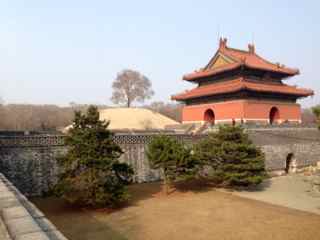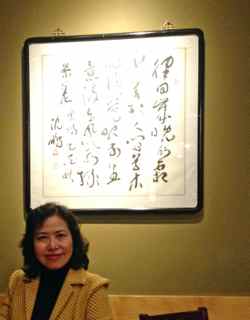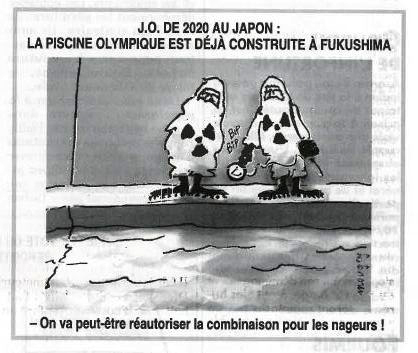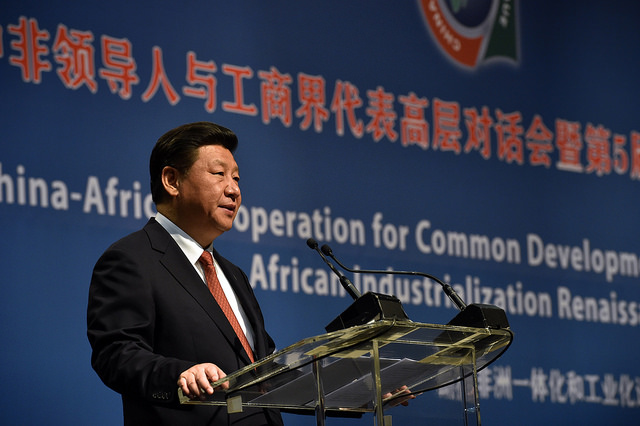by Bill Lee
He who knows when he can fight and when he cannot will be victorious.
— Sun Tzu
Prime Minister Shinzo Abe has released his much awaited statement on the 70th anniversary of the end of the Second World War. Expectations for it ran the whole gamut, from very low – fears of a new outbreak of tensions if the statement turned its back on previous apology statements – to very high – hopes for a lasting period of reconciliation with a full-throated apology. While the fallout from the statement is still waiting to be seen, immediate reactions to it have been predictable. Xinhua rightly described the statement as being full of “rhetorical twists,” South Korean President Park Guen-hye said it left “much to be desired,” and the United States, Britain, and Australia welcomed the statement. However, none of the reactions have seemed to understand the statement from the Japanese context, and thus have missed what Abe was really trying to say. What is needed is a closer reading of the statement to understand Abe’s argument. In this paper I will first look at the buildup to Abe’s statement, provide a close reading of the actual language and arguments in the declaration, and consider China’s options from now in dealing with Japan.
Buildup
Worries about Abe’s 70th anniversary statement were spurred when the Abe administration launched a panel to look at the way the 1993 Kono Statement on Japan’s sex slaves was drafted. That statement and the way compensation was offered to the former sex slaves is a very good example of the deft – or tricky – “end run” maneuvers in Japanese diplomacy. Kono’s recognition of and apology for the military-controlled brothel system were certainly sincere and well-intentioned, and Kono himself, the only Liberal Democratic Party president not to become prime minister, has always had a dovish reputation within conservative circles. Japan could have resolved the sex slave problem then in 1993 by reinforcing Kono’s statement with appropriate compensation to the former sex slaves. However, the government, still bound, as with an albatross around its neck, to its position that all redress claims had been settled with the San Francisco Peace Treaty and other post-war agreements, refused to offer compensation from official government coffers, but instead hit on the alternative of providing its compensation through a private fund, the Asian Women’s Fund, which the government tried to sell as a fund representing all of the Japanese people, and not just the government, and thus an expression of the contrition of the nation as a whole. Not unsurprisingly many of the former comfort women were not taken in and rejected the offering. Although Abe has been often slammed by critics who claim he is trying to “whitewash” the issue, Abe has consistently maintained in Diet testimony that his administration will not alter the Kono Statement and that he is “deeply pained to think of the comfort women who experienced immeasurable pain and suffering.”
Abe’s grip on reality took a turn for the worse when he claimed in Diet testimony in 2013 that there was no established legal definition of “aggression.” Here Abe was clearly parroting the ultranationalist view that there were no internationally accepted statues in international law on aggression and that Japan did not invade China but was merely fighting a war of self-defense against Western aggressors. The absurdity of these claims was even refuted by the staunchly conservative government supporter the Yomiuri Shimbun, which in an editorial on August 7, 2015 stated:
[A]cts of sending troops into territories of a foreign country and infringing on its sovereignty have been defined by historians as ‘aggression’…the series of acts from the Manchurian Incident onward obviously constituted ‘aggression.’ It is irrational to refute that it was for the purpose of defense…It is not acceptable to argue defiantly that the United States and European countries also committed aggression. It is also wrong to assert that Japan waged the war for the liberation of Asia.
Abe nimbly defused the issue by saying that the “interpretation of history should be left to historians” and that since he is “not a historian,” he is not in a position to judge.
Abe also repeatedly said that his war statement would be “future-oriented,” which most observers believed that to mean Abe would not apologize for the war and would instead emphasize Japan’s international contributions since the war and presumably into the future. Indeed, at his much anticipated speech at the 60th Bandung Conference in April 2015, Abe offered no apology and only “deep remorse” over the war. Unlike former Prime Minister Junichiro Koizumi’s 2005 Bandung speech, Abe did not use the key words “colonial rule and aggression” or “heartfelt apology,” which China-baiter Koizumi did.
Thus the stage was set. Abe also made a closely watched speech to the US Congress at the end of April this year that seemed to provide further hints of what he would say in his war statement. He convened a panel – what is life without another panel – to give him their opinion on what he should include in his statement. And in the week or so leading up to August 14, when the statement was to be released, the news surfaced that Emperor Akihito himself would offer an apology for the war. This would clearly be a counterbalance to an apology-less statement from Abe that could save Japan’s skin.
Close Reading
The first sentence of Abe’s statement is significant: “On the 70th anniversary of the end of the war, we must calmly reflect upon the road to war.” Abe is poised to give a cool, objective account of the war. This is in contrast to the Murayama Statement, which begins with the declaration that “my heart is overwhelmed by a flood of emotions.” Abe then sets the historical context for the war by stressing the encroachment of Western powers, with “waves of colonial rule surg[ing] toward Asia in the 19th century.” Abe asserts that Japan modernized after the opening of the country by the Black Ships to protect itself, noting that Japan was able to keeps its independence. The idea that Japan was a savior country in the eyes of the colonized is introduced when Abe says Japan’s victory in the Russo-Japanese War “gave encouragement to many people under colonial rule.” This is the standard nationalist line: Japan modernized to protect itself from predators and not to get in on the imperialist game itself, and Japan’s victory over Russia was due to its superiority, which it was, rather than to Russia’s long supply lines from St. Petersburg and military incompetence under a corrupt and dying Tsarist reign.
After briefly mentioning World War I and its aftermath, Abe discusses the run-up to World War II. The standard nationalist view, of course, is that Japan was forced to invade Manchuria and attack the United States at Pearl Harbor because of the economic stranglehold being put on Japan by the West and America’s oil boycott. Abe follows that line in a muted way. He notes that Japan at first “kept steps” with the international community in seeking world peace through the League of Nations and other efforts. “However,” he says, “with the Great Depression setting in and the Western countries launching economic blocs by involving colonial economies, Japan’s economy suffered a major blow.” He then says Japan became isolated and attempted to break out of the “deadlock” (ikizumari) with force, Japan’s own political system unable to control these moves. At the end of this analysis, Abe grudgingly admits Japan “took the wrong course” and advanced towards war. Although Abe concedes Japan was wrong, the tone of the description is oddly removed and passive. By using “Japan” (日本) rather than “our country” (我が国) as the subject for the sentences in these two paragraphs, Abe conveys the feeling that Japan was some kind of disengaged historical entity, a different country from the one of which he is now prime minister. Part of this aura of disconnectedness is due to the nature of the Japanese language, which emphasizes objective description over subjective explanation, but there are certainly ways around that, and I believe Abe intentionally sought to describe Japan in an “historical context” of being isolated and without options.
That is it for Abe’s explanation of the historical context for Japan’s belligerence. Abe’s statement that Japan “gradually [italics mine] transformed itself into a challenger to the new international order” surely surprised Koreans, who saw their country annexed by Japan in 1910. The interbellum period between the two world wars and into the Second World War indeed saw Japan enter the darkest chapter in its history. Yet in its early wars with China and Russia, Japan emerged with an excellent international reputation, at least according to Western observers of the wars at that time. The military historian S.C.M. Paine notes in her book The Sino-Japanese War of 1894-1895 that Japanese soldiers, unlike later Russian soldiers, did not pillage the countryside but paid for all the food they took, and treated Chinese prisoners of war relatively humanely, though that is also disputed. The point is that Japan, intoxicated with power and conquest, changed into an evil force. That is something Abe and other nationalists cannot admit about their grandfathers’ generation, whom they see as kindly and noble (re: the famous photograph of Abe sitting on the knees of his grandfather Nobusuke Kishi, once held as a war criminal). They will never change their views, which are so deeply entrenched in their psyches.
Abe next offers his condolences to the war dead in three poorly written paragraphs, which likely satisfy no one. Abe (or of course the actual writers of the statement) probably considered long and hard whether to mention the Japanese war dead first and then the dead in the invaded countries or vice versa. Quibbles can be made about the order, but I do not think it matters much if the passages are well written. The detailed description of the suffering by the Japanese — the number (three million), location (battlefields, Hiroshima, Okinawa, etc.), and degree of suffering (extreme cold or heat, starvation and disease, etc.) — paints the Japanese as victims. The next paragraph focusing on the overseas war dead seems almost like an afterthought. It begins strangely: “Also in countries that fought against Japan….” The “also” makes it seem like just supplementary information, and the sentence order — “countries that fought against Japan” — gives the impression that Japan had a rather passive role. The right note would have been: “The countries that Japan invaded….” Rather than “Also in countries,” the Japanese original is “…kuniguni demo”, (even in countries). Why “even in countries”? Why not “in other countries as well”?
While lacking numbers and types and degree of suffering, except for “numerous innocent victims” and “severe deprivation of food,” this second paragraph does something remarkable: it mentions the sex slaves. Though the phrase “sex slaves” or the euphemism “comfort women” are not used, it is clear that the “women behind the battlefields” refers to the sex slaves. People can argue that they should have been explicitly named, but this is the first time sex slaves have been referenced in any of these prime ministerial statements.
The third paragraph begins with a very clear and unequivocal admission of wrongdoing: “Upon the innocent people did our country inflict immeasurable damage and suffering.” Nothing could be more straightforward than that. Here would have been the most logical and opportune point to offer an apology: “We caused immeasurable damage and suffering; I offer my heartfelt apologies for that.” It would have been a powerful moment that assuaged many wounds. Instead, with unintended irony Abe says that all this has made him “speechless” (kotoba o ushinai). A novel reason for not making an apology emerges. All of this grief has made Abe literally unable to make an apology because he has been rendered “speechless.” I wish Abe or the statement drafters had been a little more attentive here.
The next sentence is haiku-like in its brevity but seemingly pregnant with meaning: “The peace we enjoy today exists only upon such precious sacrifices. And therein lies the origin of postwar Japan.” (これほどまでの尊い犠牲の上に、現在の平和がある。これが、戦後日本の原点であります.) The “sore ga” in the original Japanese presumably refers to peace built on the sacrifices of the war dead. But what was the origin of postwar Japan? What was the psyche of the Japanese just after the war, particularly towards the countries they had invaded? Perhaps most ordinary Japanese were too preoccupied with just surviving and wanted to forget the nightmare of the last days of the war. But what of the political elite? Much has been discussed about the degree of guilt, shame, and sense of responsibility the elites felt about the war. Ruth Benedict of course maintained that Japanese felt shame rather than guilt, thus explaining a predisposition not to apologize out of guilt but to feel “deep remorse” out of a feeling of shame. Masao Maruyama famously pointed out that none of the war leaders felt a sense of responsibility for the war because everything was done in the name of the Emperor. Thus when the Emperor was not made to take responsibility at the Tokyo Tribunal, it obviated the need for any leader to take responsibility. However, these psychological assessments are difficult to validate. From a purely instrumental view, the postwar political leaders like Nobusuke Kishi and Shigeru Yoshida, supported and funded by the United States to stand against communist regimes in the Soviet Union and China and leftist groups in Japan, which wanted Japan to atone for the war, sought nothing more than to conceal Japan’s actions during the war, particularly their own. Moreover, South Korea and China were not in a position to demand apologies. South Korea had to deal with the Korean War, and the later regime of Park Chung-hee made no demands on Japan because of Park’s affinity for Korea’s former colonial overseer. Mao Zedong and the PRC were of course preoccupied with the civil war and so on, and were disinclined to make demands for an apology, especially considering the well-known fact now that Mao kept his troops from fully engaging the Japanese invaders and that the Kumomintang army bore the brunt for the resistance. Thus a number of purely instrumental reasons buried the need for apologies for the war.
Abe next paraphrases Article 9 of the Japanese Constitution, quoting directly from it in saying that Japan will “never again resort to any form of the threat or use of force as a means of settling international disputes.” He then says Japan “made this pledge” (そう誓いました) with “deep repentance for the war.” However, a “pledge,” although solemn, is not bound by law. Abe has turned the Constitution, which is the fundamental law of the land, into a “pledge.” Perhaps this is why he believes the Constitution can be changed simply by a reinterpretation of it by a sitting government.
The next paragraph has received the most attention. It is an apology, or at first glance, seems so. He uses the centerpiece phrases “deep remorse” and “heartfelt apology.” Yet it turns out that it is not an apology from him directly but a statement that “[s]uch a position articulated by the previous Cabinets will remain unshakable into the future.” It is not a personal apology directly from Abe, but a recognition that past administrations have apologized and will continue to do so in the future. Abe had hinted that he would not necessarily use the language of previous statements of apology, but he used all four key phrases in his statement: “aggression (shinryaku),” “colonial domination (shokuminchi shihai),” “deep remorse (tsusetsu na hansei),” and “apology (owabi).” Perhaps this was Abe’s “Plan B” version of his statement. With plunging approval ratings caused by his administration’s attempt to ram through his security-related legislation through parliament and the prospect of a visit to China in September that he did not want to endanger, Abe may have felt he needed to strike a conciliatory line by at least half-apologizing. It was another great irony as Abe tried to stave off his falling popularity, which is due to his China-inspired “war legislation,” by somewhat apologizing to save his trip to China, which he hopes will help him regain the trust of the Japanese (and Chinese) public. And he did not want to be hung out to dry by the possibility that the Emperor himself would offer an apology. In the end, however, the indirect apology was a politically expedient move that satisfied neither the Chinese or Koreans nor Japanese nationalists.
However, the key passage in the entire statement for me is the next paragraph. “[N]o matter kind of efforts we may make,” Abe says, “the sorrows of those who lost their family members and the painful memories of those who underwent immense sufferings by the destruction war will never be healed” (italics mine). That, in a nutshell, is how Abe views apologizing: no matter how often or deeply Japan apologizes, the wounds will never be healed; therefore, it is does no good (shikata ga nai) to continue apologizing. Indeed apologizing could be counterproductive. As Jennifer Lind points out in her book Sorry States, every time a Japanese leader apologizes for the war, some influential right-wing figure or organization refutes the apology, spurring charges that Japan is really unrepentant. Apologizing starts a downward spiral of denial, recrimination, strained relations, and so on. Apologizing, Abe seems to believe, is a broken record that continues playing the same old tune.
Then if not apologizing, what? Abe makes that clear next: expressing gratitude. Abe marvels at “how much emotional struggle” there must have been for the “Chinese people who underwent all the sufferings of the war” to become “so tolerant nevertheless.” Because of this tolerance, Abe says, Japan was able to “return to the international community.” Therefore, Abe concludes, “Japan would like to express its heartfelt gratitude to all the nations and all the people who made every effort for reconciliation.” Despite singling out China’s suffering, Abe particularly notes the “goodwill and assistance” extended by the United States, Australia, and the European nations, nations to which Japan was most interested in exporting its products in the postwar period. So it is gratitude rather than an apology that Abe would like to offer.
With an admission of guilt and an apology comes the need to provide compensation; with an expression of gratitude comes the desire to provide gifts. Japan has officially said that its compensation requirements have been all settled by past treaties and agreements. But gifts can be offered through official development assistance (ODA), which Japan certainly extended to China and South Korea as de facto compensation. In the end, Japan would have been better off calling all the billions of dollars it extended to China war reparations rather than ODA.
Abe spends the rest of the statement making his “future-oriented” promises about what lies ahead. He says that Japan will work for nuclear nonproliferation, the rights of women, alluding again to the sex slaves, free trade, poverty eradication, health care, education, and, finally, peace.
Options for China
Not surprisingly former Prime Minister Tomiichi Murayama was critical of Abe’s statement. Giving the pithiest appraisal of it, Murayama said, “It was full of flowery language, and I couldn’t understand what he was trying to say.” Britain, Australia, and the United States welcomed the statement, South Korea gave a “prudent” response, and China zeroed in on the lack of a personal apology from Abe.
With all the buildup to Abe’s statement and now that it has been made public, the ball seems to be in China’s court. What must President Xi Jinping be thinking about the statement? Perhaps not much. It was reported that when he was Hong Kong governor, Chris Patten complained to Deng Xiaoping how complicated things were in Hong Kong. Deng snorted, and said, “If you think it is difficult running Hong Kong, think what it is like trying to run all of China.” Xi Jinping surely has a lot on his plate now — the flagging economy, the stock market plunge, the Tianjin explosions, and so on. How must he see his options? There are three obvious options: 1) take a hardline, reject the statement, and demand a correct historical understanding; 2) keep up the pressure but show a willingness to engage Japan politically and economically; 3) accept Abe’s statement, put the past behind, and seek reconciliation. The first option would be emotionally satisfying, popular with public sentiment, especially the Weibo kind, and not in China’s economic interests. The third could win Xi Jinping a Nobel Prize for peace, placate the region’s apprehensions about China’s perceived potential for aggression, and open up a fresh new era in Sino-Japanese relations. The second option is the most likely. China has already ramped down tensions around the Senkaku Islands and, with Xi’s friendlier demeanor toward Abe at Bandung, indicated a more pragmatic course towards Japan. Xi knows China needs Japanese investment. Apparently, Abe’s visit to China during the ceremonies marking the “Victory Day of the Chinese People’s War of Resistance Against Japan” in early September is a done deal. Like German Chancellor Angela Merkel, who attended a ceremony marking Russia’s victory over Germany but skipped the military parade, Abe will attend a ceremony or two commemorating the end of the war in China but will not attend the military parade. Abe’s visit at that time would certainly put Abe in the position of a supplicant and Xi in the position of a forgiving “emperor.” Through crafty diplomacy, Xi is in the driver’s seat.
Ghost Fleet, a new techno- military thriller written by two military analysts has taken Washington by storm. It is supposed to be a prophetic tale of how China overcomes America’s military might by technology to win the opening rounds in a future war against the United States. As a novel, it is lousy, as all such thrillers are, but it tries to show how the seeming technological and military superiority and hubris of a future China might all just be illusionary because, after all, America has tremendous military power and is not going to roll over and play dead. The book’s intended message is that military expansion is, in the end, a fool’s errand. It is hoped that Abe and his nationalists and Xi Jinping and the PLA will take notice, so that both sides can go back to the business of doing business.
 日本語
日本語 English
English 中国語
中国語
 Treasure Top at the Zhaoling Tomb. Note the solitary tree at the top of the mound.
Treasure Top at the Zhaoling Tomb. Note the solitary tree at the top of the mound.


